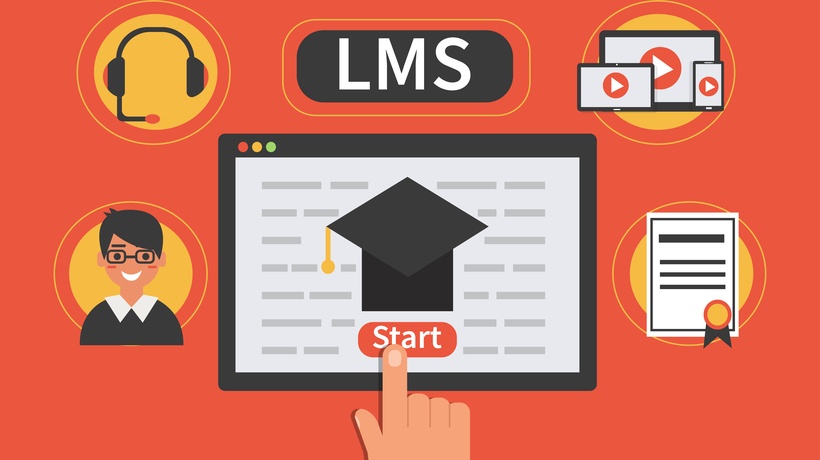2025's Best LMS For Higher Education: What Leading Institutions Are Using
Wondering why 2025 marks a turning point in higher education's digital journey? Let's find out! As colleges and universities continue to navigate the lasting impact of remote learning and growing student expectations, 2025 is proving to be a make-or-break year for digital transformation in academia. Institutions can no longer rely on outdated systems or patchwork solutions. Not to mention that today's students demand seamless, personalized, and engaging learning experiences. That's where an LMS for higher education comes into play.
Designed to manage, deliver, and track educational content, LMS platforms are now essential infrastructure for higher education. Whether you're part of a university IT team, an academic decision-maker, or an educator looking to improve digital instruction, this guide is for you.
In this article, we will explore the best LMSs for higher education in 2025, comparing top-rated platforms, highlighting key features, and reviewing insights from real users. Whether you're evaluating Blackboard alternatives, researching Moodle competitors, or seeking the best LMS for colleges and universities, we've done the research so you don't have to. Let's find the right fit for your institution's next chapter.
Best LMSs For Higher Education Institutions In 2025 (Top Picks)

If your company is listed among the Best Higher Education LMS Solutions in 2025, feel free to add this badge to your website.
360Learning's AI-powered platform helps higher education teams create engaging content, foster collaboration, and build tailored Academies to drive knowledge sharing and skill development.
Transform how your students learn. Book a demo today and see the difference!
Want to learn more about the user experience? Make sure to explore 360Learning reviews in our directory.
Highlights
- Collaborative Learning
- Personalized Academies
- Assessments And Learning Paths
Highlights
- Collaborative Learning
AI-powered authoring empowers faculty and Subject Matter Experts to create content at scale. Boost engagement with interactions to foster active learning and knowledge sharing.
- Personalized Academies
Build custom Academies and ship tailored learning experiences for each group, making it easy for learners to find relevant training and boosting completion rates.
- Assessments And Learning Paths
Guide learners with structured paths and built-in assessments. Track progress, reinforce skills, and ensure learning objectives are consistently met.
Plans And Pricing
360Learning's flexible plans adapt to diverse sizes and needs. With collaborative learning, scalable content creation, tailored learner experiences, and efficient administration, 360Learning supports higher education end-to-end.
iSpring Solutions is a global education technology provider with 23 years of experience in developing eLearning software. Their mission is to empower educators and institutions to create effective learning experiences at scale.
Ready to enhance your academic programs and engage students with iSpring Learn and its powerful capabilities? Discover iSpring Learn.
Get a feel for the platform—explore iSpring Learn reviews and see what others think.
Highlights
- Scalable Learning Environment
- Easy Content Creation And Delivery
- Engaging Gamification Features
Highlights
- Scalable Learning Environment
From small departments to large universities, iSpring Learn grows with you to support thousands of students and automate manual processes like enrollment and course assignment.
- Easy Content Creation And Delivery
Create and manage courses, knowledge checks, and blended programs in a single eLearning ecosystem, perfect for both in-person and remote learning environments.
- Engaging Gamification Features
Encourage engagement with points, badges, and leaderboards to foster healthy competition, drive more active participation, and boost course completion rates.
Plans And Pricing
iSpring Learn offers a flexible pricing system for organizations and teams of different sizes. Choose a pricing plan based on the services and features you need. Pricing starts at $3.75 per user per month, billed annually.
ELB Learning offers a wide range of products and services designed to track and deliver training content, including their LMS, Rockstar Learning Platform. These solutions help prepare students for academic and real-world success.
Request a free account or sign up for a demo by visiting their website.
Reviews say a lot; see how they stack up by reading Rockstar Learning Platform reviews in our directory.
Highlights
- Interactive Learner Activities
- Peer-Based, Social Learning
- Event Manager
Highlights
- Interactive Learner Activities
Convert video, audio, and documents into interactive learning. Engage students with self-paced modules that support knowledge checks and critical thinking.
- Peer-Based, Social Learning
Incorporate user-generated content through social channels, which act as a playlist of courses created by SMEs that can be shared with individuals or groups.
- Event Manager
Seamlessly manage lectures, workshops, and live sessions. Combine virtual instruction with in-person activities for a complete hybrid learning experience.
Plans And Pricing
Rockstar Learning Platform scales to meet the needs of colleges and universities of all sizes. Pricing is based on user count and can be enhanced with courseware, content tools, and data migration to fit your institution's growth.
Absorb is a strategic Learning Management System that supports global learning. A centralized platform that offers a range of tools and capabilities to build, manage, and deliver world-class resources that improve learner outcomes.
Scale your learning programs and offer opportunities that grow talent, boost revenue, and keep your institution competitive.
Want the inside scoop on them? Head over to the Absorb LMS reviews section.
Highlights
- Remove Barriers To Learning
- Custom-Branded Experience
- Promote Participation
Highlights
- Remove Barriers To Learning
Make learning accessible with an intuitive platform that works on any device, anytime. Whether learners are on campus or online, with libraries full of inclusive content.
- Custom-Branded Experience
Build your own learning culture with branded, customizable dashboards, billboards, color schemes, recent news, and event announcements for your academic mission.
- Promote Participation
Provide a collaborative environment that caters to modern student expectations with built-in discussion forums and chat tools that make it easier for learners to connect.
Plans And Pricing
Absorb LMS customizes its pricing based on your needs to help you deliver effective training programs. By factoring in the number of learners and what you want to achieve, they ensure you pay for what you need and have a scalable learning partner for growth.
GoSkills is an all-in-one learning platform for delivering and managing educational content. AI-powered personalization and microlearning help students and educators build real-world skills anytime, anywhere.
Make teaching easier and learning more effective. Deliver engaging training, automate admin work, and streamline course management. Start free!
Learn from real experiences. Check out GoSkills reviews now, by real users.
Highlights
- Bite-Sized, Gamified Learning
- AI-Powered Personalization
- Learning Management, Simplified
Highlights
- Bite-Sized, Gamified Learning
Engage students with short lessons and gamified elements like coins, leaderboards, and tiers. Self-paced, rewarding, and ideal for busy schedules or flipped classrooms.
- AI-Powered Personalization
Build custom courses, deliver smart content recommendations, and support learners 24/7 with an AI tutor that guides them through every step.
- Learning Management, Simplified
Assign courses, track progress with real-time insights and reports, and manage live or online training, all in one easy-to-use platform.
Plans And Pricing
GoSkills is built to meet the hybrid learning needs of higher education. Combine self-paced courses with live sessions and track it all in one platform. Start for free, then upgrade to a flexible, accessible plan that grows with your institution's needs.
Top LMS For Higher Education: Ranking Criteria Explained
Globally recognized LMS specialists, including C. Pappas and our experienced Editorial team, carefully evaluated each vendor's qualifications. They reviewed published resources like articles, eBooks, and webinars in detail. Based on their findings, our panel ranked the top AI-powered LMS solutions for training and education using nine specific criteria:
- Customer support
- Customer experience
- Software features
- Software innovation
- Customer reviews
- Economic growth potential
- Company's customer retention
- Employee turnover
- Company's social responsibility
Once you've checked out our AI LMS rankings, take a moment to dive deeper into expert tips for choosing the right platform for your needs. Use the insights we've shared to guide your decision-making process. Consider this handpicked list your starting point in finding the ideal AI-powered LMS for your organization.
What Is An LMS For Higher Education?
A Learning Management System for higher education is a digital platform that enables colleges and universities to efficiently manage, deliver, and track academic content and student progress. Not only does it streamline course administration, but it also enhances the learning experience for both educators and students.
In fact, the best LMS for higher education supports a wide range of teaching formats, whether you're running fully online courses, blended learning programs, or traditional classroom settings with digital support. It brings everything together in one place: assignments, quizzes, discussions, grades, and even video lectures are all accessible from a central hub.
Moreover, unlike general-purpose platforms, higher education LMS systems are designed with academic complexity in mind. They support multiple departments, semester schedules, and advanced reporting tools, making them a smart investment for long-term institutional success. Therefore, if you're looking for an LMS for colleges or universities, it's essential to choose a solution that not only meets today's needs but can also adapt to future demands.
Why Use An LMS For Higher Education?
Choosing the best LMS for higher education isn't just about adopting new technology; it's about transforming the way learning happens across campuses. As institutions face rising enrollment, diverse learning needs, and evolving accreditation standards, an LMS provides the structure and flexibility needed to meet these challenges head-on.
First and foremost, a well-designed LMS offers centralized access to academic content, making it easier for students and instructors to stay organized and engaged. Additionally, it supports collaboration and communication beyond the classroom, which is especially valuable in hybrid or fully online programs. Here are some of the key benefits of using an LMS in higher education.
1. Improved Course Management
Instructors can upload course materials, automate grading, and manage deadlines, all in one place.
2. Flexible Learning Options
Whether courses are in-person, online, or blended, LMS platforms support multiple delivery methods with ease.
3. Data-Driven Insights
Administrators and faculty can track student performance, identify at-risk learners, and improve academic outcomes through analytics and reporting tools.
4. Enhanced Student Engagement
Tools like discussion forums, interactive quizzes, and video content help maintain interest and improve retention.
5. Streamlined Communication
Messaging systems, announcements, and email integrations make it easier to connect with students in real time.
6. Scalability And Integration
Most top LMS platforms integrate with student information systems and third-party tools, making them ideal for growing institutions.
Ultimately, using an LMS gives institutions the ability to modernize teaching and learning while ensuring consistency, accessibility, and academic excellence.
How To Choose The Best LMS For Higher Education: Core Features To Look For
Selecting the best LMS for higher education requires more than just comparing a few flashy interfaces. In today's fast-paced academic environment, institutions need a platform that is not only reliable but also adaptable to their unique needs. So, it's essential to evaluate each system based on its functionality, user experience, and long-term value.
While every university or college may have different priorities, certain core features should be nonnegotiable. To make an informed decision, let's explore the most important features to look for when evaluating top LMS platforms for higher ed.
User-Friendly LMS For Higher Education Interface
The system should be intuitive for both students and instructors, reducing the learning curve and improving adoption rates.
Customizable Course Management
Flexibility to organize content, manage multiple sections, and support different teaching styles is a must.
Robust Assessment Tools
Look for quiz builders, assignment workflows, grading rubrics, and automatic feedback options that streamline evaluation.
Integration Capabilities
The best Learning Management System platforms integrate easily with SIS, library tools, and third-party apps like Zoom or Turnitin.
Mobile Accessibility
Since many students access content on the go, a mobile-friendly or app-supported LMS is critical.
Data Analytics And Reporting
Advanced tracking tools allow faculty and administrators to monitor engagement, assess outcomes, and make data-informed decisions.
Security And Compliance
Ensure the LMS meets data privacy standards and supports accessibility and FERPA compliance.
Because the LMS will serve as the backbone of your digital learning environment, it's worth investing the time to compare options carefully and prioritize long-term scalability over quick wins.
7 LMS For Higher Education Use Cases You Should Know
In 2025, colleges and universities are fully integrating LMS platforms into their academic ecosystems—not just to deliver content, but to improve learning outcomes, increase flexibility, and support student success at scale. Here are some of the most common and impactful ways higher education institutions are using LMSs today.
1. Delivering Hybrid And Online Courses
Many institutions are running blended learning models where lectures, assignments, and discussions are hosted online while in-person sessions are used for deeper collaboration or lab work. This approach gives students greater flexibility and supports varied learning styles.
2. Tracking Student Engagement And Performance
Faculty and administrators are using LMS analytics dashboards to monitor student activity, identify who may be struggling, and offer early interventions before it's too late.
3. Facilitating Competency-Based Education
Some institutions have adopted learning models where students progress based on mastery rather than time spent in class. The LMS provides personalized learning paths, assessments, and progress tracking to support this structure.
4. Supporting Large-Scale Course Management
Universities are using LMS platforms to manage hundreds of sections across multiple departments, ensuring consistency in curriculum, grading, and communication across campuses.
5. Enabling Global Learning Access
With the help of multilingual content, mobile-friendly platforms, and asynchronous modules, LMSs are being used to deliver higher education to learners across different countries and time zones.
6. Encouraging Peer-To-Peer Learning
Discussion boards, group projects, and collaborative workspaces within LMS platforms are fostering a sense of academic community, even in remote or hybrid environments.
7. Streamlining Administrative Tasks
Instructors and academic staff are automating grading, scheduling, and course enrollment processes through the LMS, freeing up time for teaching and research.
Overall, higher education institutions are no longer viewing LMSs as optional tools. They're essential digital infrastructure for delivering accessible, engaging, and data-informed learning at scale.
How Colleges And Universities Are Using LMS For Higher Education In 2025
Higher education institutions are embracing some of the best LMS for higher education platforms to streamline learning and boost engagement. Below are some compelling real-world examples.
Dedicated Learning Centre
Jawaharlal Nehru University (JNU) is investing ₹11 crore to build a dedicated eLearning centre equipped with content creation studios and virtual classrooms, all supported by advanced LMS infrastructure. This initiative enables them to offer up to 40% of their credits online, expanding access for remote learners.
MOOCs And Distance Education Programs With Gamification
The University of the Philippines Open University (UPOU) uses a Moodle-based higher education LMS system to deliver MOOCs and distance education programs. Gamification elements like badges and leaderboards have significantly boosted course completion rates.
98% User Satisfaction
Open LMS EDU (formerly Moodle-based) serves over 10 million users across more than a thousand institutions. Universities like Waseda and Silliman report 98% satisfaction, rapid deployment, and smooth integration with student information systems.
Online Instruction And Hands-On Hardware Labs
The Tennessee College of Applied Technology at Shelbyville implemented a cloud-based Moodle LMS to combine online instruction with hands-on hardware labs for PLC and SCADA systems, making it one of the first to offer real-time hardware training via the cloud.
Testing Competencies
Western Governors University runs a competency-based LMS model that allows students to advance by mastering material, not by semesters. This student-centered platform empowers over 150,000 learners nationwide.
Improved Academic Outcomes
The University of Cape Coast used its LMS to track student engagement, resulting in greater interaction and improved academic outcomes compared to traditional methods. Research from Brightspace showed LMS analytics can predict at-risk students with over 90% accuracy, enabling targeted support interventions arxiv.org.
These success stories show that forward-thinking institutions are leveraging Learning Management System software not only to deliver content but also to enhance accessibility, retention, interactivity, and predictive insights. As a result, the best LMS platforms are becoming central to digital transformation in higher education, helping colleges and universities meet evolving student needs.
Common LMS For Higher Education Challenges (And How To Solve Them)
While the best LMS for higher education can transform learning, implementation doesn't come without challenges. Institutions often face resistance, technical hurdles, and usability issues when rolling out new learning platforms. Fortunately, most of these barriers can be overcome with the right strategy and support. Here are some of the most common challenges and how to address them.
Lack Of Faculty Buy-In
When instructors aren't involved in the decision-making process or don't receive proper training, they may be reluctant to adopt a new LMS.
Solution: Involve faculty early on, offer ongoing training, and showcase success stories to build confidence and enthusiasm.
Insufficient Training And Support
Students and staff alike may struggle to navigate the platform without clear guidance.
Solution: Provide orientation sessions, create help guides, and maintain a responsive support team to assist users throughout the transition.
Technical Integration Issues
Compatibility with existing systems like SIS or library databases can become a roadblock.
Solution: Choose LMS vendors known for smooth integrations and prioritize platforms with OpenAPI and robust support.
Low Student Engagement
Simply uploading PDFs or slides won't encourage active participation.
Solution: Use interactive tools, quizzes, forums, and gamified elements to create engaging and dynamic learning experiences.
Budget Constraints
High licensing or setup costs may limit options, especially for smaller institutions.
Solution: Compare pricing models carefully and consider open-source or cloud-based solutions to reduce overhead.
By anticipating these issues and planning ahead, institutions can implement an LMS that meets academic goals while supporting students and faculty every step of the way.
Conclusion: Choosing The Best LMS For Higher Education In 2025
As we move through 2025, one thing is clear: higher education is undergoing a digital transformation, and the institutions leading the way are those that have embraced innovation with purpose. The best LMS for higher education is no longer just a nice-to-have but the backbone of a modern academic experience that values flexibility, accessibility, and measurable outcomes.
From enabling hybrid learning to supporting global access and streamlining course management, LMS platforms are helping colleges and universities meet the complex demands of today's learners. However, choosing the right system isn't simply about ticking boxes. It requires a thoughtful look at features, integration capabilities, long-term value, and user satisfaction.
Throughout this guide, we've covered what makes an LMS essential, how institutions are using them in 2025, and the key features and challenges to consider. We've also highlighted real use cases showing how higher education LMS systems are improving student engagement, academic performance, and institutional efficiency.
If you're currently searching for the right LMS for your college or university, don't guess—compare. Head over to our LMS directory where you can filter, evaluate, and explore top platforms side by side. Take advantage of free trials or book a demo to see how each tool performs in action before making a commitment.
Ultimately, the right LMS will not only meet your current academic needs—it will evolve with you, scale with your programs, and empower both faculty and students to thrive in a digital-first world.
FAQ About Choosing The Best LMS For Higher Ed
When it comes to selecting the best LMS for higher education, it's natural to have questions. After all, the right choice can impact everything from student success to faculty satisfaction. Here are some frequently asked questions institutions consider during the decision-making process.
Higher education LMS platforms are designed to handle semester schedules, credit tracking, and academic hierarchies, while corporate LMSs focus more on compliance, certifications, and short-term training modules.
Start by defining your institution's priorities, like ease of use, integration needs, or mobile access. Then use a Learning Management System comparison checklist to evaluate features, support, scalability, and total cost of ownership.
Open-source tools like Moodle can be cost-effective and customizable. However, they may require more technical support in-house. If your IT team is limited, a managed or cloud-based solution may be a better fit.
Top LMS providers typically offer onboarding, training, customer service, and ongoing tech support. Be sure to check customer reviews and case studies for insights on responsiveness and reliability.
Depending on the complexity of the system and your institution's size, implementation can take anywhere from a few weeks to several months. Planning, training, and communication are key to a smooth rollout.









